| Isabel II barrio-pueblo Isabel IIIsabel Segunda | |
|---|---|
| Municipality Seat | |
 Town Hall in Isabel II Town Hall in Isabel II | |
 | |
| Coordinates: 18°08′51″N 65°26′33″W / 18.147362°N 65.442628°W / 18.147362; -65.442628 | |
| Commonwealth | |
| Municipality | |
| Area | |
| • Total | 0.50 sq mi (1.3 km) |
| • Land | 0.36 sq mi (0.9 km) |
| • Water | 0.14 sq mi (0.4 km) |
| Elevation | 66 ft (20 m) |
| Population | |
| • Total | 1,207 |
| • Density | 3,352.8/sq mi (1,294.5/km) |
| Source: 2010 Census | |
| Time zone | UTC−4 (AST) |
Isabel II barrio-pueblo (referred to as Isabel Segunda in Spanish) is a barrio and the administrative center (seat) in the downtown area in the island-municipality of Vieques, Puerto Rico. Its population in 2010 was 1,354.
| Census | Pop. | Note | %± |
|---|---|---|---|
| 1910 | 3,158 | — | |
| 1920 | 3,424 | 8.4% | |
| 1930 | 3,101 | −9.4% | |
| 1940 | 2,678 | −13.6% | |
| 1950 | 3,085 | 15.2% | |
| 1960 | 2,487 | −19.4% | |
| 1970 | 2,378 | −4.4% | |
| 1980 | 1,807 | −24.0% | |
| 1990 | 1,702 | −5.8% | |
| 2000 | 1,459 | −14.3% | |
| 2010 | 1,207 | −17.3% | |
| U.S. Decennial Census 1900 (N/A) 1910-1930 1930-1950 1980-2000 2010 | |||
The central plaza and its church
As was customary in Spain, in Puerto Rico, the municipality has a barrio which contains a central plaza, the municipal buildings (city hall), and a Catholic church. Fiestas patronales (patron saint festivals) are held in the central plaza every year.
The central plaza, or square, is a place for official and unofficial recreational events and a place where people can gather and socialize from dusk to dawn. The Laws of the Indies, Spanish law, which regulated life in Puerto Rico in the early 19th century, stated the plaza's purpose was for "the parties" (celebrations, festivities) (Spanish: a propósito para las fiestas), and that the square should be proportionally large enough for the number of neighbors (Spanish: grandeza proporcionada al número de vecinos). These Spanish regulations also stated that the streets nearby should be comfortable portals for passersby, protecting them from the elements: sun and rain.
Located across the central plaza in Isabel II barrio-pueblo is the Parroquia Inmaculada Concepción, a Roman Catholic church, which was first built in 1844.
History
Isabel II was in Spain's gazetteers until Puerto Rico was ceded by Spain in the aftermath of the Spanish–American War under the terms of the Treaty of Paris of 1898 and became an unincorporated territory of the United States. In 1899, the United States Department of War conducted a census of Puerto Rico finding that the combined population of Pueblo and Florida barrios was 2,646.
In July 2020, Federal Emergency Management Agency appropriated funds for repairs to Vieques' plaza.
Sectors
Barrios (which are, in contemporary times, roughly comparable to minor civil divisions) in turn are further subdivided into smaller local populated place areas/units called sectores (sectors in English). The types of sectores may vary, from normally sector to urbanización to reparto to barriada to residencial, among others.
The following sectors are in Isabel II barrio-pueblo:
Barriada Fuerte, Calle Antonio G. Mellado, Calle Baldorioty de Castro, Calle Benítez Castaño, Calle Carlos Lebrum, Calle Muñoz Rivera, Calle Plinio Peterson, Calle Prudencio Quiñones, Calle Tomás Pérez Brignoni, Calle Víctor Duteill, Calle 65 de Infantería, Condominio Terra San Francisco, Sector Buena Vista, Sector Cañón, Sector Leguillow, and Sector Pueblo Nuevo.
Historic sites and features
Isabel II barrio-pueblo is the location of several historic sites listed on the U.S. National Register of Historic Places, including:
- Fuerte de Vieques (El Fortín Conde de Mirasol)
- Casa Alcaldia de Vieques
- Casa Augusto Delerme
- Casa Delerme-Anduze No. 2
- Casa de Jaime Puig Lemoine
- Delerme-Anduze House
- Las Tumbas de J. J. Maria le Guillou
- Rafael Acevedo House
- Smaine-Ortiz House
Gallery
Places in Isabel II barrio-pueblo:
-
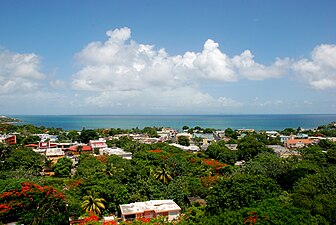 Scenic panorama of Isabel Segunda
Scenic panorama of Isabel Segunda
-
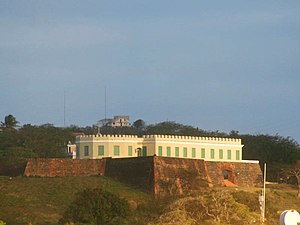 El Fortín Conde de Mirasol
El Fortín Conde de Mirasol
-
 300-year-old Ceiba Tree
300-year-old Ceiba Tree
-
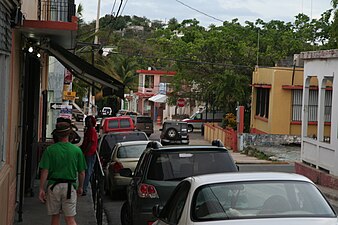 Street in Isabel II barrio-pueblo
Street in Isabel II barrio-pueblo
-
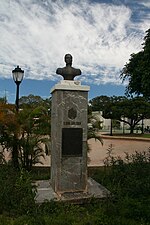 Statue of Simon Bolivar
Statue of Simon Bolivar
-
 The City Hall
The City Hall
-
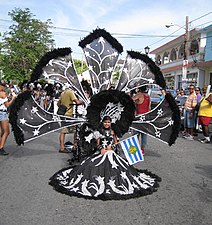 Patron saint festival celebration in 2008
Patron saint festival celebration in 2008
See also
References
- ^ "US Gazetteer 2019". US Census. US Government.
- U.S. Geological Survey Geographic Names Information System: Isabel II barrio-pueblo
- Picó, Rafael; Buitrago de Santiago, Zayda; Berrios, Hector H. Nueva geografía de Puerto Rico: física, económica, y social, por Rafael Picó. Con la colaboración de Zayda Buitrago de Santiago y Héctor H. Berrios. San Juan Editorial Universitaria, Universidad de Puerto Rico,1969.
- Gwillim Law (20 May 2015). Administrative Subdivisions of Countries: A Comprehensive World Reference, 1900 through 1998. McFarland. p. 300. ISBN 978-1-4766-0447-3. Retrieved 25 December 2018.
- Puerto Rico: 2010 Population and Housing Unit Counts.pdf (PDF). U.S. Dept. of Commerce, Economics and Statistics Administration, U.S. Census Bureau. 2010.
- "Report of the Census of Porto Rico 1899". War Department Office Director Census of Porto Rico. Archived from the original on July 16, 2017. Retrieved September 21, 2017.
- "Table 3-Population of Municipalities: 1930 1920 and 1910" (PDF). United States Census Bureau. Archived (PDF) from the original on August 17, 2017. Retrieved September 21, 2017.
- "Table 4-Area and Population of Municipalities Urban and Rural: 1930 to 1950" (PDF). United States Census Bureau. Archived (PDF) from the original on August 30, 2015. Retrieved September 21, 2014.
- "Table 2 Population and Housing Units: 1960 to 2000" (PDF). United States Census Bureau. Archived (PDF) from the original on July 24, 2017. Retrieved September 21, 2017.
- Puerto Rico: 2010 Population and Housing Unit Counts.pdf (PDF). U.S. Dept. of Commerce Economics and Statistics Administration U.S. Census Bureau. 2010. Archived (PDF) from the original on 2017-02-20. Retrieved 2019-08-02.
- ^ Santullano, Luis A. (10 March 2019). "La Plaza y la Calle". Mirada al Caribe. Vol. 54. Colegio de Mexico. pp. 75–78. doi:10.2307/j.ctvbcd2vs.12. JSTOR j.ctvbcd2vs.12.
- Pariser, Harry S. (2003). Explore Puerto Rico, Fifth Edition. San Francisco: Manatee Press. pp. 52–55. Retrieved 10 February 2019.
- Mari Mut, José A. (2013-08-28). Los Pueblos de Puerto Rico y Las Iglesias de Sus Plazas [The Pueblos of Puerto Rico, and the Churches of its Plazas] (PDF) (in Spanish). Archived (PDF) from the original on 2020-12-14. Retrieved 2021-09-16.
- "Anuario del comercio, de la industria, de la magistratura y de la administración. 1881". Biblioteca Nacional de España (in Spanish). p. 1614. Retrieved 4 April 2023.
- Joseph Prentiss Sanger; Henry Gannett; Walter Francis Willcox (1900). Informe sobre el censo de Puerto Rico, 1899, United States. War Dept. Porto Rico Census Office (in Spanish). Imprenta del gobierno. p. 164.
- "FEMA Approves Funds to Repair PR Town Squares". Hudson Valley Press. 2020-07-08. Retrieved 2021-09-23.
- "US Census Barrio-Pueblo definition". factfinder.com. US Census. Archived from the original on 13 May 2017. Retrieved 5 January 2019.
- "Agencia: Oficina del Coordinador General para el Financiamiento Socioeconómico y la Autogestión (Proposed 2016 Budget)". Puerto Rico Budgets (in Spanish). Retrieved 28 June 2019.
- Rivera Quintero, Marcia (2014), El vuelo de la esperanza: Proyecto de las Comunidades Especiales Puerto Rico, 1997-2004 (first ed.), San Juan, Puerto Rico Fundación Sila M. Calderón, ISBN 978-0-9820806-1-0
- "Leyes del 2001". Lex Juris Puerto Rico (in Spanish). Retrieved 24 June 2020.
- "PRECINTO ELECTORAL VIEQUES 096" (PDF). Comisión Estatal de Elecciones (in Spanish). PR Government. 7 November 2018. Archived from the original (PDF) on 25 June 2020. Retrieved 24 June 2020.